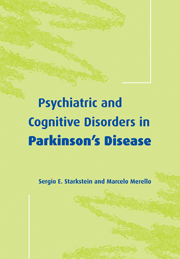Book contents
- Frontmatter
- Contents
- Preface
- 1 Introduction
- 2 Epidemiologic, clinical, and therapeutic aspects of Parkinson's disease
- 3 Parkinsonism and Parkinson's disease
- 4 Cognitive deficits in Parkinson's disease
- 5 Depression in Parkinson's disease
- 6 Anxiety, phobias, apathy, and premorbid personality in Parkinson's disease
- 7 Neuropsychologic and psychiatric side-effects of antiparkinsonian medication
- 8 Treatment of psychiatric disorders in Parkinson's disease
- Appendix
- References
- Index
2 - Epidemiologic, clinical, and therapeutic aspects of Parkinson's disease
Published online by Cambridge University Press: 13 August 2009
- Frontmatter
- Contents
- Preface
- 1 Introduction
- 2 Epidemiologic, clinical, and therapeutic aspects of Parkinson's disease
- 3 Parkinsonism and Parkinson's disease
- 4 Cognitive deficits in Parkinson's disease
- 5 Depression in Parkinson's disease
- 6 Anxiety, phobias, apathy, and premorbid personality in Parkinson's disease
- 7 Neuropsychologic and psychiatric side-effects of antiparkinsonian medication
- 8 Treatment of psychiatric disorders in Parkinson's disease
- Appendix
- References
- Index
Summary
Involuntary tremulous motion, with lessened muscular power, in parts not in action and even when supported, with a propensity to bend the trunk forwards, and to pass from a walking to a running pace: the senses and intellects being uninjured.
James Parkinson, 1817Introduction
Since its initial description in 1817, PD remains an unsolved clinical problem, with a changing focus during the past four decades. Thus, the 1960s were the years of dopamine discovery; the 1970s witnessed a leap forward in the treatment of the disease by the introduction of replacement therapy with l-dopa; the 1980s witnessed motor complications emerging from chronic long-term l-dopa treatment; and the 1990s were primarily devoted to genetic and neuroimaging studies, the search for putative biological markers, and the rebirth of surgical treatment for the disease.
This chapter will examine relevant epidemiologic, clinical, and therapeutic aspects of PD and will provide the neurologic basis for the in-depth discussion of neuropsychiatric and cognitive aspects of the disease that follows.
Clinical vignette
A.B. is a 54-year-old accountant who noticed mild tremor in his right hand while reading the newspaper. A diagnosis of PD was made and the patient was started on l-dopa, which was followed by the disappearance of tremor. One year later, he noticed tremor during stressful situations, and his signature became smaller. He also noticed dragging of his right foot when walking. This overall picture illustrates the period of stable response to l-dopa.
Two years later, the patient developed clumsiness in both legs and abnormal gait. […]
- Type
- Chapter
- Information
- Publisher: Cambridge University PressPrint publication year: 2002



